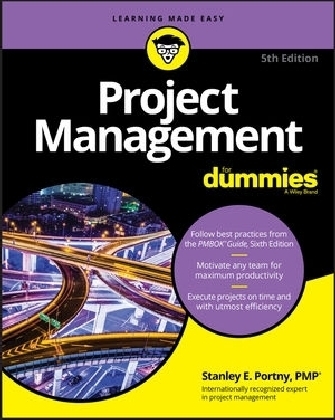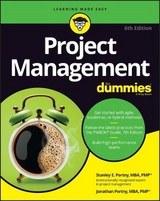
Project Management For Dummies
John Wiley & Sons Inc (Verlag)
978-1-119-34890-0 (ISBN)
- Titel erscheint in neuer Auflage
- Artikel merken
The bestselling 'bible' of project management In today's time-crunched, cost-conscious global business environment, tight project deadlines and stringent expectations are the norm. So how can you juggle all the skills and responsibilities it takes to shine as a project management maven? Updated in a brand-new edition, Project Management For Dummies offers everything you need to successfully manage projects from start to finish without ever dropping the ball. Written by a well-known project management expert, this hands-on guide takes the perplexity out of being a successful PM, laying out all the steps to take your organizational, planning, and execution skills to new heights. Whether it's managing distressed projects, embracing the use of social media to drive efficiency and improve socialization, or resolving conflicts that occur during a project, the soup-to-nuts guidance inside will help you wear your project management hat more prominently and proudly.
* Get the latest in industry best practices reflecting PMBOK 6 * Motivate any team to gain maximum productivity * Execute projects on time and with maximum efficiency * Prepare for the Project Management Professional (PMP) certification exam It's never been easier to execute projects on time, on budget, and with maximum efficiency.
Stanley E. Portny, PMP®, is an internationally recognized expert in project management and project leadership. During the past 30 years, he has provided training and consultation to more than 150 public and private organizations. He is a Project Management Institutecertified Project Management Professional (PMP®).
Introduction 1
About This Book 2
Foolish Assumptions 2
Icons Used in This Book 3
Beyond the Book 4
Where to Go from Here 4
Part 1: Getting Started with Project Management 7
Chapter 1: Project Management: The Key to Achieving Results 9
Determining What Makes a Project a Project 10
Understanding the three main components that define a project 10
Recognizing the diversity of projects 11
Describing the four phases of a project life cycle 13
Defining Project Management 14
Starting with the initiating processes 16
Outlining the planning processes 17
Examining the executing processes 18
Surveying the monitoring and controlling processes 19
Ending with the closing processes 20
Knowing the Project Manager’s Role 20
Looking at the project manager’s tasks 20
Staving off excuses for not following a structured project-management approach 21
Avoiding shortcuts 22
Staying aware of other potential challenges 23
Do You Have What It Takes to Be an Effective Project Manager? 24
Questions 24
Answer key 25
Relating This Chapter to the PMP Exam and PMBOK 6 26
Chapter 2: Beginning the Journey: The Genesis of a Project 27
Gathering Ideas for Projects 28
Looking at information sources for potential projects 29
Proposing a project in a business case 29
Developing the Project Charter 31
Performing a cost-benefit analysis 32
Conducting a feasibility study 34
Generating documents during the development of the project charter 35
Deciding Which Projects to Move to the Second Phase of Their Life Cycle 36
Chapter 3: Knowing Your Project’s Stakeholders: Involving the Right People 37
Understanding Your Project’s Stakeholders 38
Developing a Stakeholder Register 38
Starting your stakeholder register 39
Ensuring your stakeholder register is complete and up-to-date 44
Using a stakeholder register template 45
Determining Whether Stakeholders Are Drivers, Supporters, or Observers 47
Deciding when to involve your stakeholders 48
Using different methods to involve your stakeholders 51
Making the most of your stakeholders’ involvement 52
Displaying Your Stakeholder Register 53
Confirming Your Stakeholders’ Authority 54
Assessing Your Stakeholders’ Power and Interest 56
Relating This Chapter to the PMP Exam and PMBOK 6 57
Chapter 4: Clarifying What You’re Trying to Accomplish — And Why 59
Defining Your Project with a Scope Statement 60
Looking at the Big Picture: Explaining the Need for Your Project 64
Figuring out why you’re doing the project 64
Drawing the line: Where your project starts and stops 74
Stating your project’s objectives 75
Marking Boundaries: Project Constraints 80
Working within limitations 80
Dealing with needs 83
Facing the Unknowns When Planning: Documenting Your Assumptions 83
Presenting Your Scope Statement in a Clear and Concise Document 84
Relating This Chapter to the PMP Exam and PMBOK 6 85
Chapter 5: Developing Your Game Plan: Getting from Here to There 87
Divide and Conquer: Breaking Your Project into Manageable Chunks 88
Thinking in detail 88
Identifying necessary project work with a work breakdown structure 90
Dealing with special situations 98
Creating and Displaying Your Work Breakdown Structure 101
Considering different schemes to create your WBS hierarchy 102
Using one of two approaches to develop your WBS 103
Categorizing your project’s work 104
Labeling your WBS entries 106
Displaying your WBS in different formats 107
Improving the quality of your WBS 110
Using templates 111
Identifying Risks While Detailing Your Work 112
Documenting What You Need to Know about Your Planned Project Work 114
Relating This Chapter to the PMP Exam and PMBOK 6 115
Part 2: Planning Time: Determining When and How Much 117
Chapter 6: You Want This Project Done When? 119
Picture This: Illustrating a Work Plan with a Network Diagram 120
Defining a network diagram’s elements 120
Drawing a network diagram 122
Analyzing a Network Diagram 123
Reading a network diagram 123
Interpreting a network diagram 125
Working with Your Project’s Network Diagram 130
Determining precedence 130
Using a network diagram to analyze a simple example 133
Developing Your Project’s Schedule 138
Taking the first steps 139
Avoiding the pitfall of backing in to your schedule 140
Meeting an established time constraint 141
Applying different strategies to arrive at your picnic in less time 141
Estimating Activity Duration 149
Determining the underlying factors 149
Considering resource characteristics 150
Finding sources of supporting information 150
Improving activity duration estimates 151
Displaying Your Project’s Schedule 152
Relating This Chapter to the PMP Exam and PMBOK 6 156
Chapter 7: Establishing Whom You Need, How Much of Their Time, and When 157
Getting the Information You Need to Match People to Tasks 158
Deciding what skills and knowledge team members must have 159
Representing team members’ skills, knowledge, and interests in a skills matrix 163
Estimating Needed Commitment 165
Using a human resources matrix 165
Identifying needed personnel in a human resources matrix 167
Estimating required work effort 168
Factoring productivity, efficiency, and availability into work-effort estimates 169
Reflecting efficiency when you use historical data 170
Accounting for efficiency in personal work-effort estimates 171
Ensuring Your Project Team Members Can Meet Their Resource Commitments 173
Planning your initial allocations 174
Resolving potential resource overloads 176
Coordinating assignments across multiple projects 179
Relating This Chapter to the PMP Exam and PMBOK 6 180
Chapter 8: Planning for Other Resources and Developing the Budget 183
Determining Non-Personnel Resource Needs 184
Making Sense of the Dollars: Project Costs and Budgets 186
Looking at different types of project costs 186
Recognizing the three stages of a project budget 188
Refining your budget as you move through your project’s phases 189
Determining project costs for a detailed budget estimate 191
Relating This Chapter to the PMP Exam and PMBOK 6 195
Chapter 9: Venturing into the Unknown: Dealing with Risk 197
Defining Risk and Risk Management 198
Focusing on Risk Factors and Risks 199
Recognizing risk factors 200
Identifying risks 204
Assessing Risks: Probability and Consequences 205
Gauging the likelihood of a risk 205
Estimating the extent of the consequences 208
Getting Everything under Control: Managing Risk 210
Choosing the risks you want to manage 211
Developing a risk-management strategy 212
Communicating about risks 213
Preparing a Risk-Management Plan 214
Relating This Chapter to the PMP Exam and PMBOK 6 216
Part 3: Group Work: Putting Your Team Together 217
Chapter 10: Aligning the Key Players for Your Project 219
Defining Three Organizational Environments 220
The functional structure 220
The projectized structure 222
The matrix structure 224
Recognizing the Key Players in a Matrix Environment 227
The project manager 228
Project team members 229
Functional managers 229
The project owner 230
The project sponsor 230
Upper management 231
Working Successfully in a Matrix Environment 232
Creating and continually reinforcing a team identity 232
Getting team-member commitment 233
Eliciting support from other people in the environment 233
Heading off common problems before they arise 234
Relating This Chapter to the PMP Exam and PMBOK 6 235
Chapter 11: Defining Team Members’ Roles and Responsibilities 237
Outlining the Key Roles 238
Distinguishing authority, responsibility, and accountability 238
Understanding the difference between authority and responsibility 239
Making Project Assignments 239
Delving into delegation 239
Sharing responsibility 244
Holding people accountable — even when they don’t report to you 246
Picture This: Depicting Roles with a Responsibility Assignment Matrix 250
Introducing the elements of a RAM 250
Reading a RAM 252
Developing a RAM 254
Ensuring your RAM is accurate 255
Dealing with Micromanagement 257
Realizing why a person micromanages 257
Gaining a micromanager’s trust 258
Working well with a micromanager 259
Relating This Chapter to the PMP Exam and PMBOK 6 259
Chapter 12: Starting Your Project Team Off on the Right Foot 261
Finalizing Your Project’s Participants 262
Are you in? Confirming your team members’ participation 262
Assuring that others are on board 264
Filling in the blanks 265
Developing Your Team 266
Reviewing the approved project plan 267
Developing team and individual goals 268
Specifying team-member roles 268
Defining your team’s operating processes 269
Supporting the development of team-member relationships 270
Resolving conflicts 270
All together now: Helping your team become a smooth-functioning unit 273
Laying the Groundwork for Controlling Your Project 275
Selecting and preparing your tracking systems 275
Establishing schedules for reports and meetings 276
Setting your project’s baseline 277
Hear Ye, Hear Ye! Announcing Your Project 277
Setting the Stage for Your Post-Project Evaluation 278
Relating This Chapter to the PMP Exam and PMBOK 6 279
Part 4: Steering the Ship: Managing Your Project to Success 281
Chapter 13: Tracking Progress and Maintaining Control 283
Holding On to the Reins: Project Control 284
Establishing Project Management Information Systems 285
The clock’s ticking: Monitoring schedule performance 286
All in a day’s work: Monitoring work effort 292
Follow the money: Monitoring expenditures 297
Putting Your Control Process into Action 301
Heading off problems before they occur 301
Formalizing your control process 302
Identifying possible causes of delays and variances 303
Identifying possible corrective actions 304
Getting back on track: Rebaselining 305
Reacting Responsibly When Changes Are Requested 305
Responding to change requests 306
Creeping away from scope creep 307
Relating This Chapter to the PMP Exam and PMBOK 6 308
Chapter 14: Keeping Everyone Informed 309
I Said What I Meant and I Meant What I Said: Successful Communication Basics 310
Breaking down the communication process 311
Distinguishing one-way and two-way communication 311
Can you hear me? Listening actively 312
Choosing the Appropriate Medium for Project Communication 314
Just the facts: Written reports 315
Move it along: Meetings that work 317
Preparing a Written Project-Progress Report 319
Making a list (of names) and checking it twice 319
Knowing what’s hot (and what’s not) in your report 320
Earning a Pulitzer, or at least writing an interesting report 322
Holding Key Project Meetings 325
Regularly scheduled team meetings 325
Ad hoc team meetings 326
Upper-management progress reviews 326
Preparing a Project Communications Management Plan 327
Relating This Chapter to the PMP Exam and PMBOK 6 328
Chapter 15: Encouraging Peak Performance by Providing Effective Leadership 331
Exploring the Differences between Leadership and Management 332
Recognizing the Traits People Look for in a Leader 333
Developing Personal Power and Influence 334
Understanding why people do what you ask 335
Establishing the bases of your power 336
You Can Do It! Creating and Sustaining Team Member Motivation 338
Increasing commitment by clarifying your project’s benefits 339
Encouraging persistence by demonstrating project feasibility 340
Letting people know how they’re doing 341
Providing rewards for work well done 342
Relating This Chapter to the PMP Exam and PMBOK 6 343
Chapter 16: Bringing Your Project to Closure 345
Staying the Course to Completion 346
Planning ahead for your project’s closure 347
Updating your initial closure plans when you’re ready to wind down the project 348
Charging up your team for the sprint to the finish line 348
Handling Administrative Issues 349
Providing a Smooth Transition for Team Members 349
Surveying the Results: The Post-Project Evaluation 352
Preparing for the evaluation throughout the project 352
Setting the stage for the evaluation meeting 353
Conducting the evaluation meeting 355
Following up on the evaluation 356
Relating This Chapter to the PMP Exam and PMBOK 6 357
Part 5: Taking Your Project Management to the Next Level 359
Chapter 17: Using Newer Methods and Resources to Enhance Your Project Management 361
Taking a Look at the Agile Approach to Project Management 362
Understanding what drives the Agile approach 362
Taking a look at the elements of Agile when implemented through Scrum 364
Comparing the Agile and traditional (Waterfall) approaches 365
Using Computer Software Effectively 366
Looking at your software options 367
Helping your software perform at its best 372
Introducing project-management software into your organization 373
Using Social Media to Enhance Project Management 374
Defining social media 374
Exploring how social media can support your project planning and performance 376
Using social media to support your project communications 377
Relating This Chapter to the PMP Exam and PMBOK 6 378
Chapter 18: Monitoring Project Performance with Earned Value Management 381
Defining Earned Value Management 382
Getting to know EVM terms and formulas 382
Looking at a simple example 386
Determining the reasons for observed variances 388
The How-To: Applying Earned Value Management to Your Project 389
Determining a Task’s Earned Value 392
Relating This Chapter to the PMP Exam and PMBOK 6 396
Part 6: The Part of Tens 397
Chapter 19: Ten Questions to Ask Yourself as You Plan Your Project 399
What’s the Purpose of Your Project? 399
Whom Do You Need to Involve? 400
What Results Will You Produce? 400
What Constraints Must You Satisfy? 400
What Assumptions Are You Making? 401
What Work Has to Be Done? 401
When Does Each Activity Start and End? 402
Who Will Perform the Project Work? 402
What Other Resources Do You Need? 403
What Can Go Wrong? 403
Chapter 20: Ten Tips for Being a Better Project Manager 405
Be a “Why” Person 405
Be a “Can Do” Person 406
Think about the Big Picture 406
Think in Detail 406
Assume Cautiously 406
View People as Allies, Not Adversaries 407
Say What You Mean and Mean What You Say 407
Respect Other People 407
Acknowledge Good Performance 407
Be a Manager and a Leader 408
Appendix: Combining the Techniques into Smooth-Flowing Processes 409
Index 413
| Erscheinungsdatum | 29.10.2017 |
|---|---|
| Verlagsort | New York |
| Sprache | englisch |
| Maße | 190 x 236 mm |
| Gewicht | 852 g |
| Themenwelt | Sachbuch/Ratgeber ► Beruf / Finanzen / Recht / Wirtschaft ► Wirtschaft |
| Wirtschaft ► Betriebswirtschaft / Management ► Projektmanagement | |
| ISBN-10 | 1-119-34890-0 / 1119348900 |
| ISBN-13 | 978-1-119-34890-0 / 9781119348900 |
| Zustand | Neuware |
| Informationen gemäß Produktsicherheitsverordnung (GPSR) | |
| Haben Sie eine Frage zum Produkt? |
aus dem Bereich



